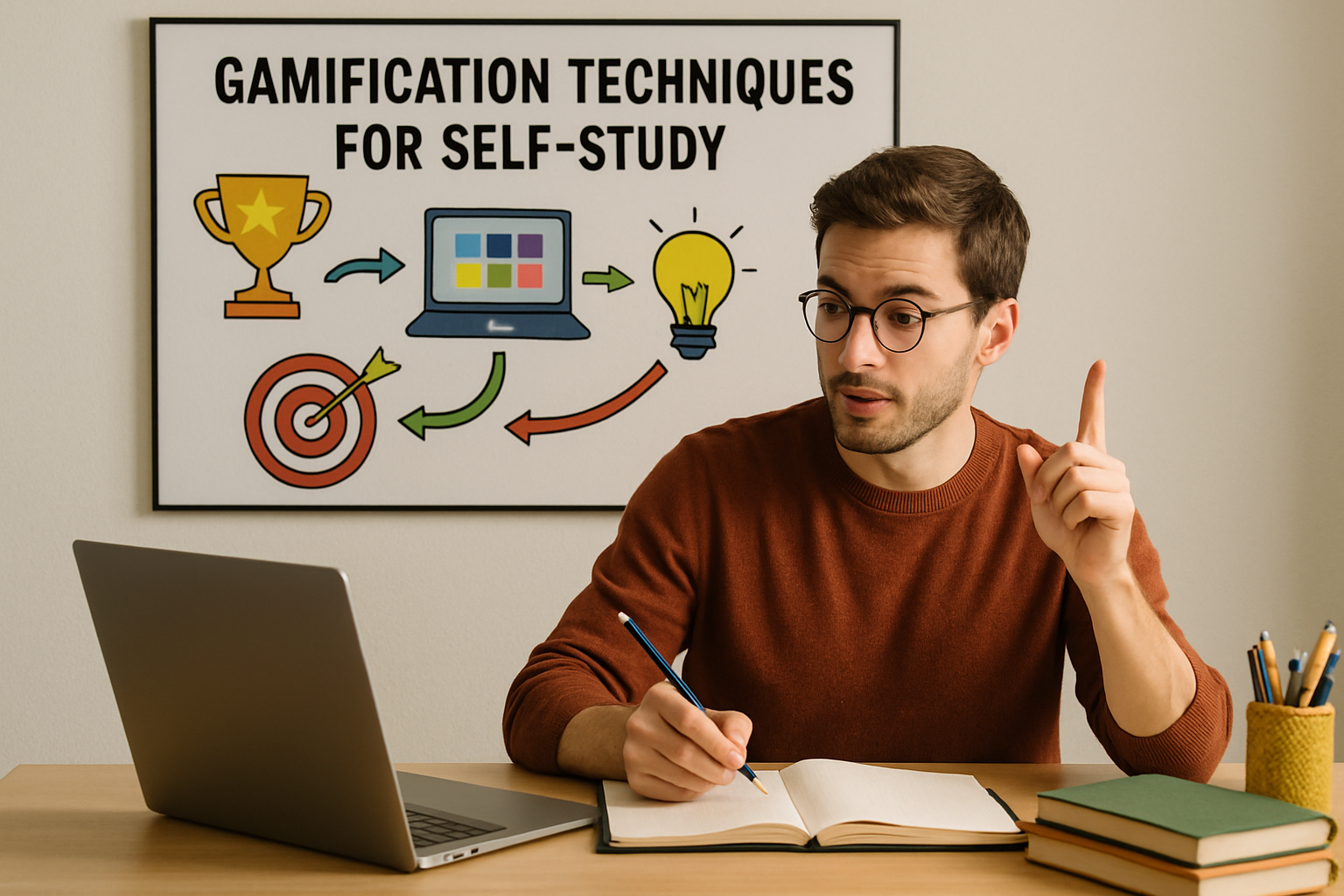
Gamification techniques for self-study
Gamification is not a buzzword—it is a toolkit that, when thoughtfully applied, transforms the solitary act of self-study into an engaging, rewarding journey. In an era where technology seamlessly integrates with our daily lives, harnessing gamification techniques is not only possible but essential, especially for those navigating independent learning paths in fast-evolving fields like technology. Through a blend of psychology, design, and digital innovation, self-learners can reframe the way they approach new skills, complex concepts, and personal development.
Understanding Gamification: More Than Just Points and Badges
At its core, gamification is the application of game design elements—such as rewards, competition, and progress tracking—to non-game contexts. For self-study, this means leveraging the mechanics that make games captivating to encourage sustained learning, deeper engagement, and a sense of accomplishment.
“Games give us unnecessary obstacles that we volunteer to tackle. Gamification invites us to see our challenges as opportunities for mastery rather than chores.”
Key elements typically used in gamification include:
- Points for progress or correct answers
- Levels that indicate mastery or progression
- Leaderboards for social comparison and motivation
- Badges to mark achievements
- Quests or missions as structured goals
- Immediate feedback on performance
However, effective gamification is not about slapping rewards onto a dull task—it’s about designing meaningful experiences that drive intrinsic motivation, especially vital for independent learners and those with neurodivergent learning profiles.
The Psychology Behind Gamification in Self-Learning
Games are compelling because they tap into several psychological needs:
- Autonomy—the freedom to choose and control one’s actions
- Competence—the satisfaction of overcoming challenges and improving skills
- Relatedness—the sense of connection with others or with a story
- Purpose—a clear sense of why a task is meaningful
Self-study can feel isolating or overwhelming, but gamification bridges this gap by creating structure, positive reinforcement, and a sense of purpose. For women in tech and neurodivergent learners—who may face unique barriers—these techniques can make learning more accessible and joyful.
Transforming Learning Tasks into Game-Like Challenges
To gamify self-study, it’s important to intentionally design your learning process as a series of engaging, achievable challenges. Here are practical ways to implement gamification techniques:
1. Define Clear Goals and Quests
Begin by breaking your learning objectives into small, actionable quests. Each quest should have a clear start and finish, and a defined reward. For example, instead of “learn Python,” a quest could be “complete a beginner’s tutorial on lists and dictionaries.”
Tip: Frame your goals as missions—“Decrypt the logic behind recursion” or “Unlock the secrets of CSS Flexbox.” This narrative element increases engagement and gives context to your progress.
2. Design a Points and Rewards System
Assign points to each completed task or correct answer, and set thresholds for rewards. The rewards can be as simple as a break, a small treat, or an activity you enjoy.
“When you gamify your learning, every step forward is a small celebration. This changes the emotional texture of studying from burden to opportunity.”
Consider using digital tools such as Habitica or Todoist, which allow you to create custom point systems and visualize your progress.
3. Level Up: Track Your Progress Visually
Visual progress is a powerful motivator. Create a progress bar, chart, or even a hand-drawn map that fills in as you complete modules. When you reach certain milestones, let yourself “level up” to more advanced material or new areas of interest.
Why it works: Visual cues provide instant feedback and a sense of closure, counteracting the feeling that self-study is endless or intangible.
4. Use Badges and Achievement Unlocks
Design custom badges for yourself as you conquer topics or build new skills. These can be digital icons, stickers on a board, or entries in a journal. For example, award yourself a “Debugging Champion” badge after resolving a tricky coding bug, or a “Presentation Pro” badge after giving a successful tech talk.
Badges are powerful because they represent public or private recognition of effort, not just outcomes.
5. Incorporate Timed Challenges and Streaks
Set time-based challenges—like “solve five coding exercises in 30 minutes”—to add a sense of urgency and excitement. Maintain streaks by studying a bit every day for a week, and reward yourself for keeping the streak alive.
Platforms such as Duolingo use streaks effectively, and you can adapt this technique for any subject. Consistency is often more valuable than intensity in self-study, and gamification makes consistency fun.
Social Elements: Competition and Collaboration in Solo Study
While self-study is typically a solitary pursuit, gamification can introduce social dynamics that boost motivation. Here’s how:
Join or Create a Learning Community
Share your goals and achievements with peers through study groups, online forums, or social media. Friendly competition—such as comparing progress charts or quiz scores—can spark motivation and make learning feel less isolating.
“Learning is not a zero-sum game. Celebrating each other’s milestones turns study into a shared adventure.”
For women and neurodivergent learners, inclusive communities provide vital support and recognition, reinforcing the message that everyone’s journey is valuable.
Peer Challenges and Accountability
Pair up with a study buddy or mentor and devise weekly challenges—like “who can build the best JavaScript mini-game?” or “who can write the clearest explanation of a machine learning algorithm?”
Accountability doesn’t have to be competitive; it can simply be a commitment to check in and encourage each other. Knowing someone else is invested in your progress can make a world of difference.
Gamification for Neurodivergent Learners
Neurodivergent learners—such as those with ADHD, autism, dyslexia, or other learning differences—often benefit disproportionately from gamified approaches. Gamification offers:
- Clear, structured pathways that reduce overwhelm
- Immediate feedback that keeps attention and provides direction
- Flexible rewards that can be tailored to individual preferences
- Opportunities for sensory engagement through visuals and interactivity
For example, a learner with ADHD might use a visual timer and progress bar to make tasks tangible, while someone with autism might appreciate the predictability and control of self-designed quests and badges.
“Gamification is not a one-size-fits-all solution. Its true power comes from adaptability and personalization.”
Many apps and platforms now allow for deep customization. Take advantage of these features to build a system that truly fits your learning style and needs.
Technology Tools for Gamifying Self-Study
While you can gamify your study with nothing more than paper and pen, technology offers a wealth of tools to supercharge your approach. Here are some standout options:
1. Habitica
This app turns your to-do list into an RPG (role-playing game), where you earn experience, level up, and collect virtual rewards for real-life achievements. You can also join “parties” with friends for collaborative quests.
2. Duolingo
Famous for language learning, Duolingo employs points, streaks, leaderboards, and badges to keep users coming back. Its approach is easily adapted to other fields using similar structures.
3. Khan Academy
Offers badges, energy points, and progress tracking across a vast library of subjects. Its mastery-based progression system keeps learners focused and motivated.
4. Customizable Kanban Boards
Tools like Trello or Notion let you build your own gamified workflows with checklists, progress bars, and milestone markers. You can create “game boards” representing levels, quests, or skill trees.
5. Codewars and HackerRank
These platforms use gamification to teach programming through coding challenges, rankings, and badges. Each completed challenge advances your “rank,” providing a clear sense of progress.
Don’t be afraid to mix and match tools, or invent your own system. The best gamification is the one that keeps you coming back, learning, and enjoying the process.
Potential Pitfalls: Avoiding Burnout and Frustration
While gamification can be transformative, it’s important to avoid common traps:
- Overemphasizing rewards: If the rewards become the only reason to study, intrinsic motivation may suffer. Balance points and badges with a genuine interest in the material.
- Perfectionism: Leaderboards and streaks can sometimes trigger anxiety or unhealthy competition. Remember, gamification is about progress, not perfection.
- Complexity overload: Don’t make your system so intricate that it becomes another task to manage. Start simple, and scale up as you find what works.
The most effective gamification is flexible, forgiving, and adaptive to your evolving needs.
Gamification as a Pathway to Lifelong Learning
In a world where technology constantly reshapes the landscape of knowledge, the ability to self-learn is a superpower. Gamification provides a bridge between intention and sustained action, turning the sometimes lonely road of independent study into an adventure filled with challenges, rewards, and growth.
Whether you’re a woman breaking new ground in technology, a neurodivergent learner seeking accessible pathways, or anyone determined to master new skills on your own terms, gamification isn’t just a tactic—it’s a philosophy. It invites you to play, to celebrate progress, and to approach learning with the curiosity and resilience of a gamer on a quest.
So, design your next study session as a game. Set your quests, track your progress, reward your achievements, and remember: every challenge overcome is not just a step forward in knowledge, but a victory in your own ongoing adventure.


